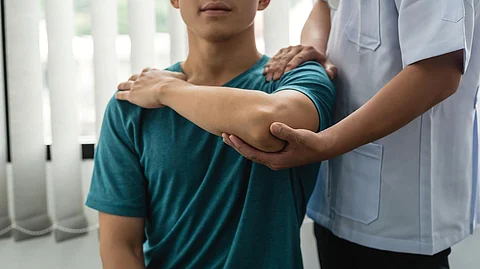Here’s everything you need to know about tennis elbow, including:
What is tennis elbow?
Tennis elbow, which is also known as lateral epicondylitis or more recently as lateral elbow tendinopathy (LET), is a common cause of elbow pain that frequently occurs in middle age and affects both men and women in equal numbers.
Tennis elbow symptoms
Tennis elbow pain often develops out of the blue and can be quite severe in intensity.
Pain is present on the outside (lateral) aspect of the elbow
Pain is increased when lifting objects, especially with the hand facing palm down
Pain is worse if the elbow is bumped or touched
Causes of tennis elbow
Tennis elbow results from age-related degeneration of the tendon that connects the wrist extensor muscles to the humerus bone at the outside part of the elbow (the part of the bone that juts out is called the lateral epicondyle). The primary risk factor for developing tennis elbow is being between the ages of 40-60 years old. Repetitive lifting or activities that require actively extending the wrist (such as hitting a backhand shot in tennis) make the pain worse, but they are not known to actually cause the problem.
How is tennis elbow diagnosed?
The diagnosis is made with a physical exam. Tenderness over the lateral epicondyle combined with increased elbow pain when the wrist is passively flexed down or when the doctor resists the patient’s attempt to extend their wrist confirms the diagnosis. X-rays are not mandatory but are often obtained to rule out arthritis or another possible cause of elbow pain. Magnetic resonance imaging (MRI) is sometimes obtained, but this is also not typically necessary.
Tennis elbow treatments
There is abundant scientific evidence that tennis elbow will resolve on its own in most patients (95%), but this can take up to a year or even more.
The first line of treatment is physical therapy, which can be done at home with appropriate instruction. A forearm strap can also be used and oral anti-inflammatory medications like ibuprofen can be taken as needed.
Injections can also be done to create bleeding at the abnormal tendon origin, which is thought to release stem cells and other naturally occurring factors that promote healing (the injected substance may be corticosteroids, saline, the patient’s own blood or even just “dry” needling with no good evidence that any one substance is best).
Newer treatments include ECSWT (extracorporeal shockwave therapy), TENS (transcutaneous electrical nerve stimulation), acupuncture, laser therapy, TENEX (ultrasonic tenotomy) and PRP (platelet rich plasma) injections, but there is no scientific evidence that any of these treatments are better than observation alone.
Surgery to remove the abnormal tendon tissue is the last option, but it is only considered if symptoms persist for more than one year. This is successful 95% of the time, but recovery usually takes three months.
How can I prevent tennis elbow?
Since tennis elbow is known to be the result of age-related tendon tissue breakdown, there is no known way its development can be prevented. It has been shown to affect 1-3% of the population.
Living with tennis elbow
As an orthopedic surgeon at Boston Medical Center, I think the most important thing to understand about tennis elbow is that it is a self-limited condition that almost always resolves on its own. Although the pain associated with it can be severe and suggest a serious problem, this condition does not cause permanent damage to the elbow.
Remembering to lift objects with the hand facing palm up rather than palm down can make activities of daily living much easier. If a patient plays racket sports, using a bigger grip can lessen discomfort when playing. Despite all of the many new treatments now marketed, there is no good evidence that any of them will shorten the time it takes for this condition to resolve on its own.
Although it can be frustrating, being patient and letting nature run its course is usually the best advice.


